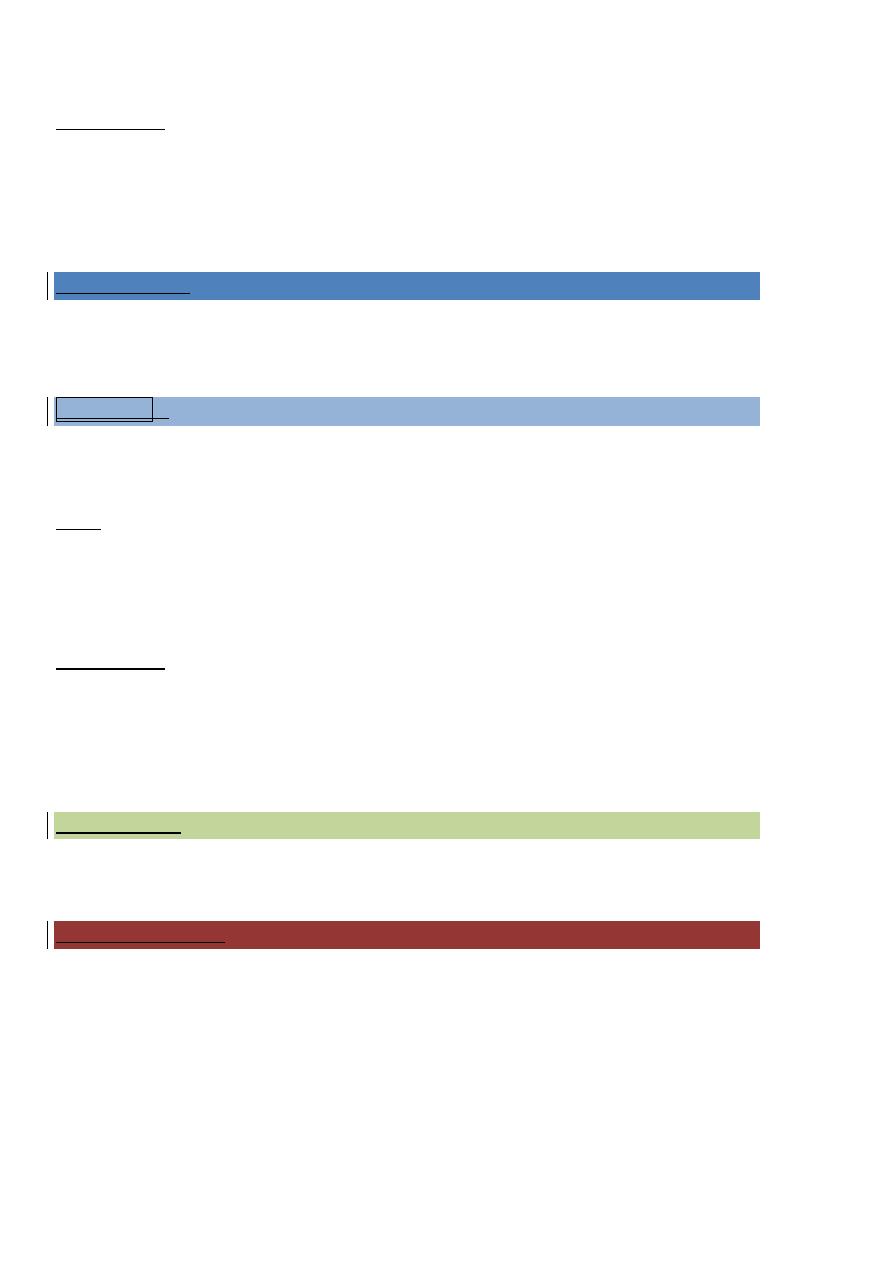
1
Pharmacology 3
rd
stage
Anti mycobacterial drugs
Tuberculosis is a bacterial ,infectious disease caused by mycobacterium tuberculosis
complex and occasionally by mycobacterium bovis and mycobacterium africanum ,these
organism are also known as tubercle bacilli (because they cause lesion called tubercle
),or acid fast bacilli (A.F.B.),that stain poorly by gram stain .
Genus mycobacterium causes tuberculosis and leprosy ;strain of mycobacterium
tuberculosis is one of a number of mycobacteria that cause tuberculosis of the lungs
,genitourinary tract ,skeleton and meanings, these bacteria characterized by :-
1-Slow growth rate(decrease activity ) and may remain dormant for years and this make
them resistant to antibiotics .
2- They are intracellular organism (inside macrophage) and many drugs poor enter
macrophage .
3- Drug resistant is rapidly develop in patients given only one drug ;therefore; multidrug
therapy is employed when treating tuberculosis .
There are two lines for treatment tuberculosis :-
1-First line treatment include ;Isonaizid +Rifampicin+Pyrazinamide with or without
Ethambutol or Streptomycin or both of them .
2- Second line treatment ;they are useful in patients who cannot tolerate the first line
drugs or who are infected with mycobacteria that are resistant to the first line agents
,but these drugs more toxic and less effective than first line drugs ;they include :-
Aminosalicylic acid , Capreomycin , Cycloserine; Ethionamide and Fluoroquinolones and
macrolides .
1-Isoniazid, (INH), Isonicotinic acid hydrazide
Its bactericidal for rapidly dividing mycobacterium T.B, It acts through inhibits mycolic
acid synthesis which is an important component of the cell wall ;It’s the most potent
agent in the treatment but it's never given as a single agent in treatment of active
tuberculosis ;its effective against intracellular bacteria and its specific for treatment of
mycobacterium tuberculosis (not used for other infection).
P/K :-
Well absorbed from GIT, absorption is impaired if Isoniazid taken with food ,the drug
diffuses into all body tissues ,the drug is concentrated in CNS and CSF is about the same

2
as that in the serum ,readily penetrates macrophages and other host cells; so it is
effective against intracellular bacilli ;it is metabolized by acetylation process in the liver
,half life is about 1 hour in the fast acetylation ,and about 3 hours in the slow
acetylation; so chronic liver diseases decrease metabolism and doses must be reduced
,excreted in urine ; usual dose of INH is 300mg as single daily dose .
Side effects :-
Side effects of INH are related to dosage and duration of administration :-
1-Peripheral neuritis ; which is the most common adverse effect ,due to pyridoxine
deficiency ,because INH has similar structure to pyridoxine that interfere with its uptake
by various tissues and usually give 10 mg vit. B6 /day as prophylactic to prevent
peripheral neuropathy .(very common in slow acetylation)
2- Hepatitis and hepatotoxicity, fatal hepatitis is the most severe side effect associated
with INH, this hepatitis is most properly due to product toxic metabolite of INH in liver
and most common in fast acetylation due to high level of metabolite of INH in fast
acetylation process .
3- Mental abnormalities ,convolution in patients prone to seizer ,optic neuritis
,hypersensitivity reaction include skin rash and fever .
2- Rifampicin :-
Abroad spectrum antimicrobial activity than INH ,it is effective against some strains of
resistance G+ve and G-ve bacteria like Staphylo cocci and Niesseria gonorrhai and
Niesseria meningesis and for leprosy ,it is never given as single agent in the treatment
active tuberculosis .It acts via inhibiting bacterial RNA synthesis by suppressing RNA
polymerase .It is bactericidal for both intracellular and extracellular mycobacteria .
P/K :-
Given orally with adequate absorption ,has good volume of distribution to all body
organs and fluids ,metabolism in the liver ,half life is 2-5 hours ,longer than INH, binding
to plasma protein about 80-90 %, while INH is very low protein binding ,it is undergo the
enterohepatic circulation ,elimination the drug metabolites is via the bile (60%),and in
urine (40%) ;usually given in single dose about 600mg/day in morning .Rifampicin is
hepatic enzyme inducer for cytochrom P-450 ,and this lead to decrease the half lives of
coadministerd drugs that are metabolized by this system and this may lead to higher
doses e.g. Warfarin, Propranolol Sulphonylureas , oral contraceptive ,Quinidine,
Digoxin, Ketoconazole, Prednisone

3
Side effects :-
1-Nausia ,vomiting ,skin rash ,flu-like syndrome .
2- Hepatic toxicity and jaundice ;therefore; liver enzyme measurements is important
especially in patients with liver diseases ,alcoholics and the elderly .
3- Change color of urine to pink red color ,and other body secretion also discolored .
Pyrazinamide :-
It is bactericidal anti tuberclecular agent ,used in combination with Isonaizid and
Rifampicin ,it is penetrate the CSF, it is undergoes extensive metabolism in the liver
,urate retention can occur and may precipitate gouty attack .
Ethambutol :-
It act by inhibits synthesis of an essential component of mycobacterial cell wall
,Ethambutol can be used in combination with Pyrazinamide ,INH and Rifampicin to treat
tuberculosis .
P/K :-
Good absorption from GIT, well distributed throughout the body ,penetrate to CNS ,and
it is therapeutically adequate in tuberculous meningitis ,half life is about 6 hours and
most of drug excreted unchanged in urine .
Side effects :-
1-Most important adverse effect is optic neuritis which result in diminished visual acuity
and loss of ability to discriminate between colors ;therefore ; frequent examination of
visual acuity and color vision is important .
2- Urate excretion is decrease by the drug ,thus gout may be exacerbated .
Streptomycin :-
Related to aminoglycoside ,usually given I.M. in treatment of T.B.in dose 1g/day .
Side effects :- ototoxicity and nephrotoxicity .
Aminosalicylic acid :-
Is used infrequent ,because it is poorly tolerated ,it is a bacteriostatic agent acts by
inhibitor for
paraaminobenzoic acid (PABA) in folate biosynthesis (similar to sulphonamide
structure).
Side effects :- interfere with iodine metabolism and can cause goiter and myxodema,
GIT upset .

4
Capreomycin:-
Is one of aminoglycoside ,also effected in some cases of T.B., given in case of resistance
bacteria .it acts by inhibits protein synthesis ,administered parenterally .side effects
,autotoxicity, nephrotoxicity and electrolytes disturbances .
Drugs for treatment leprosy:-
Dapson :-
it is a bacteriostatic for mycobacterium leprae ,related to sulphonamides and act by the
same mechanism of Sulphonamide (antagonist PABA and inhibit folate biosynthesis )
,the drug is well absorbed from GIT ,good volume of distribution with high level
concentration in the skin ,the drug is eliminated by the kidney .
Side effects :-
GIT symptoms , allergic reaction include erythema nodosum leprosum ,haemolysis in
G6PDD patients and peripheral neuropathy .
